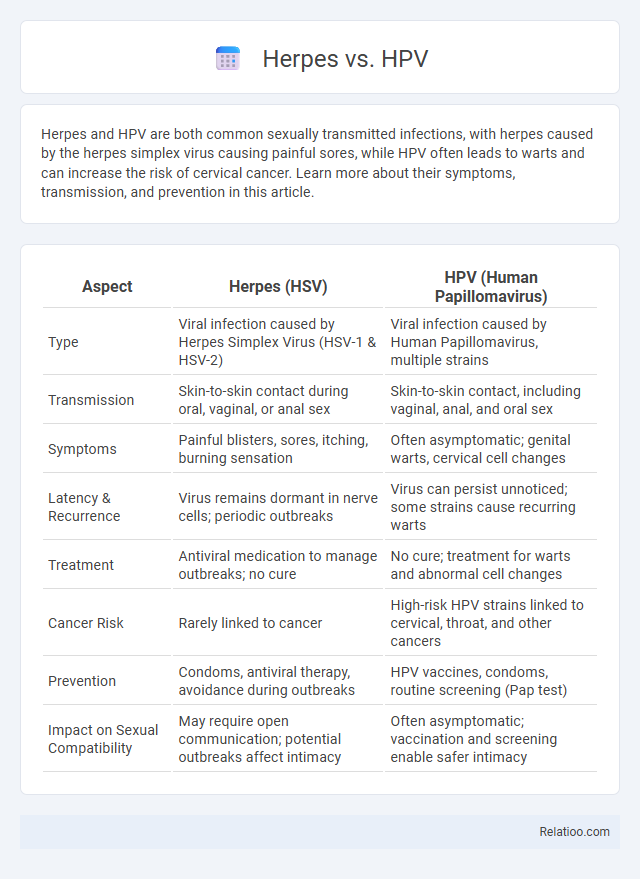Herpes and HPV are both common sexually transmitted infections, with herpes caused by the herpes simplex virus causing painful sores, while HPV often leads to warts and can increase the risk of cervical cancer. Learn more about their symptoms, transmission, and prevention in this article.
Table of Comparison
| Aspect | Herpes (HSV) | HPV (Human Papillomavirus) |
|---|---|---|
| Type | Viral infection caused by Herpes Simplex Virus (HSV-1 & HSV-2) | Viral infection caused by Human Papillomavirus, multiple strains |
| Transmission | Skin-to-skin contact during oral, vaginal, or anal sex | Skin-to-skin contact, including vaginal, anal, and oral sex |
| Symptoms | Painful blisters, sores, itching, burning sensation | Often asymptomatic; genital warts, cervical cell changes |
| Latency & Recurrence | Virus remains dormant in nerve cells; periodic outbreaks | Virus can persist unnoticed; some strains cause recurring warts |
| Treatment | Antiviral medication to manage outbreaks; no cure | No cure; treatment for warts and abnormal cell changes |
| Cancer Risk | Rarely linked to cancer | High-risk HPV strains linked to cervical, throat, and other cancers |
| Prevention | Condoms, antiviral therapy, avoidance during outbreaks | HPV vaccines, condoms, routine screening (Pap test) |
| Impact on Sexual Compatibility | May require open communication; potential outbreaks affect intimacy | Often asymptomatic; vaccination and screening enable safer intimacy |
Overview: Understanding Herpes and HPV
Herpes and HPV are two common sexually transmitted infections caused by different viruses: herpes simplex virus (HSV) and human papillomavirus (HPV). Understanding the differences between these infections is crucial for Your sexual health, as herpes often causes painful sores and recurring outbreaks, while many HPV strains may be asymptomatic but can lead to genital warts or cervical cancer. Regular screening and safe sexual practices significantly reduce the risk of transmission and help manage these infections effectively.
Causes: What Triggers Herpes and HPV?
Herpes is triggered by the herpes simplex virus (HSV), primarily HSV-1 and HSV-2, which are activated by factors such as stress, illness, or a weakened immune system. Human papillomavirus (HPV) results from exposure to specific strains of the HPV virus, often transmitted through skin-to-skin contact during sexual activity. Your risk of both infections increases with unprotected sex and multiple partners, highlighting the importance of preventive measures and regular screenings.
Transmission: How Herpes and HPV Spread
Herpes simplex virus (HSV) spreads primarily through direct skin-to-skin contact during oral, genital, or anal sex, with transmission possible even when no visible sores are present. Human papillomavirus (HPV) is transmitted via intimate skin-to-skin contact, including vaginal, anal, and oral sex, often through microscopic skin abrasions facilitating viral entry. Both herpes and HPV are highly contagious sexually transmitted infections (STIs) that can transmit asymptomatically, underlining the importance of preventive measures such as condom use and regular screening.
Symptoms: Differentiating Herpes vs HPV
Herpes presents with painful, blister-like sores primarily around the genital or oral areas, accompanied by itching and burning sensations during outbreaks. HPV often causes painless genital warts or may remain asymptomatic, with some high-risk strains leading to cervical or other cancers over time. Unlike other sexually transmitted infections that may exhibit flu-like symptoms or discharge, Herpes and HPV require specific clinical examinations for accurate diagnosis due to overlapping signs.
Diagnosis: Testing Methods for Herpes and HPV
Accurate diagnosis of herpes and HPV relies on specific testing methods tailored to each infection. Herpes is commonly diagnosed through viral culture, polymerase chain reaction (PCR) tests from lesion swabs, and blood tests detecting antibodies. HPV diagnosis typically involves Pap smears for cervical cell abnormalities and HPV DNA tests identifying high-risk viral strains, helping you manage and monitor sexually transmitted infections effectively.
Treatment: Managing Herpes and HPV Infections
Treatment for managing herpes primarily involves antiviral medications such as acyclovir, valacyclovir, or famciclovir, which help reduce outbreak frequency and viral shedding. Human papillomavirus (HPV) infections often require monitoring and intervention like topical treatments, cryotherapy, or surgical removal of warts, while persistent high-risk HPV strains may necessitate regular screenings for cervical cancer prevention. Your healthcare provider can guide appropriate treatment plans to effectively manage these sexually transmitted infections and minimize complications.
Complications: Health Risks of Herpes and HPV
Herpes and HPV are common sexually transmitted infections (STIs) with distinct health risks and complications. Herpes can cause painful sores, recurrent outbreaks, and increases the risk of transmitting HIV. HPV is linked to cervical cancer, genital warts, and other cancers affecting the throat, anus, and genitals, emphasizing the importance of regular screenings to protect Your long-term health.
Prevention: Reducing the Risk of Herpes and HPV
Reducing the risk of herpes and HPV involves consistent use of barrier methods such as condoms and dental dams during sexual activity to minimize skin-to-skin contact and viral transmission. Regular screenings and HPV vaccinations play crucial roles in preventing infections and related complications, especially cervical cancer caused by high-risk HPV strains. You can further decrease the risk by limiting the number of sexual partners and avoiding sexual contact during active outbreaks of herpes.
Myths vs Facts: Common Misconceptions
Herpes and HPV are distinct sexually transmitted infections (STIs) often confused due to overlapping symptoms and misinformation. A common myth is that herpes and HPV always cause visible sores or warts, whereas many individuals remain asymptomatic, making regular screenings crucial for detection. Contrary to misconceptions, both infections can lead to serious health complications, such as cervical cancer for HPV and recurrent outbreaks for herpes, emphasizing the importance of accurate knowledge and preventative measures.
When to See a Doctor: Seeking Medical Advice
If you notice persistent or unusual symptoms such as sores, warts, itching, or pain in the genital area, it is important to see a doctor promptly to differentiate between herpes, HPV, or other sexually transmitted infections (STIs). Early diagnosis through clinical examination and lab tests can help manage symptoms and reduce the risk of complications. Your healthcare provider can offer targeted treatment, advice on prevention, and necessary follow-up care to protect your sexual health.

Infographic: Herpes vs HPV
 relatioo.com
relatioo.com